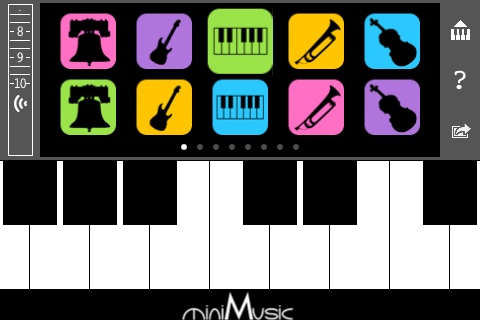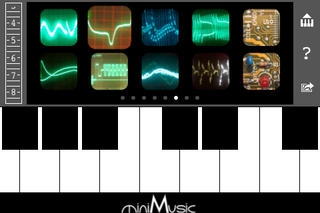Pianofly
Price: $1.99
Version Reviewed: 1.0
Sound [rating:4/5]
iPhone Integration [rating:5/5]
User Interface [rating:4/5]
Re-use / Replay Value [rating:4/5]
Overall Rating:





It's challenging enough to shrink a QWERTY keyboard to fit onto an iPhone or iPod touch screen, but how in the world can you possibly squeeze a piano-style keyboard into the same itty bitty space? That's been the challenge for creators of music apps like Grand Pro and Pianist. Most display only about an octave slice of keys on the screen at any one time. Pianofly Pro Synth by miniMusic does the same, but the app features an interesting means of letting the user move up and down the keyboard from there. The player simply swipes to the left or right while holding down a key. This allows for fluid access to an entire 88-key keyboard.

The one complaint with this approach is that Pianofly's keys can sometimes accidently slide under finger. Also, an app that restricts the onscreen range to an octave still results in awfully small keys. Pianofly is a polyphonic instrument, allowing you to play more than one note at a time, but don't plan on banging out the chords for "Bennie and the Jets" unless you have skinny fingers.
As it's name suggests, Pianofly Pro Synth is one part virtual piano and one part synthesizer. However, if you buy it thinking it'll create realistic piano sounds, you'll be disappointed. Other apps that playback recorded samples of actual acoustic pianos sound much more realistic. Instead of samples, Pianofly uses FM synthesis to build sounds by combining basic waveforms. This approach is not well suited for emulating acoustic instruments. In fact, when I let a small group of music faculty from the college where I teach try out the app, they simply laughed at Pianofly's trumpet, violin, and electric guitar sounds. But oohs and ahhs replaced the laughter when they then tried the presets from Pianofly's synthesizer-oriented instrument bank.
The instrument bank contains eight pages, each having ten presets presented as icons. Double tap on a sound icon and an edit screen appears that allows you to edit up to three "nodes" per sound. Each node generates a waveform, with the user being able to choose among sine, triangle, sawtooth, and the like, for each. The nodes can be combined to build complex sounds. The waveforms generated by the nodes can also used to modulate one another in interesting ways. This is the heart of FM or frequency modulation synthesis.
Pianofly also allows the user to alter the amplitude envelope for each node. This is the attack, initial decay, sustain, and release of the sound. For example, a snare drum note has a faster attack than, say, a flute.
Taken together, Pianofly's abilities as a synthesizer make it a great a choice for musicians interested in electronic sound production. Its "flying keys" approach to moving up and down the register also provides an interesting solution to a significant problem encountered by all apps that incorporate a piano-style keyboard. Just don't buy it for its piano sound.












